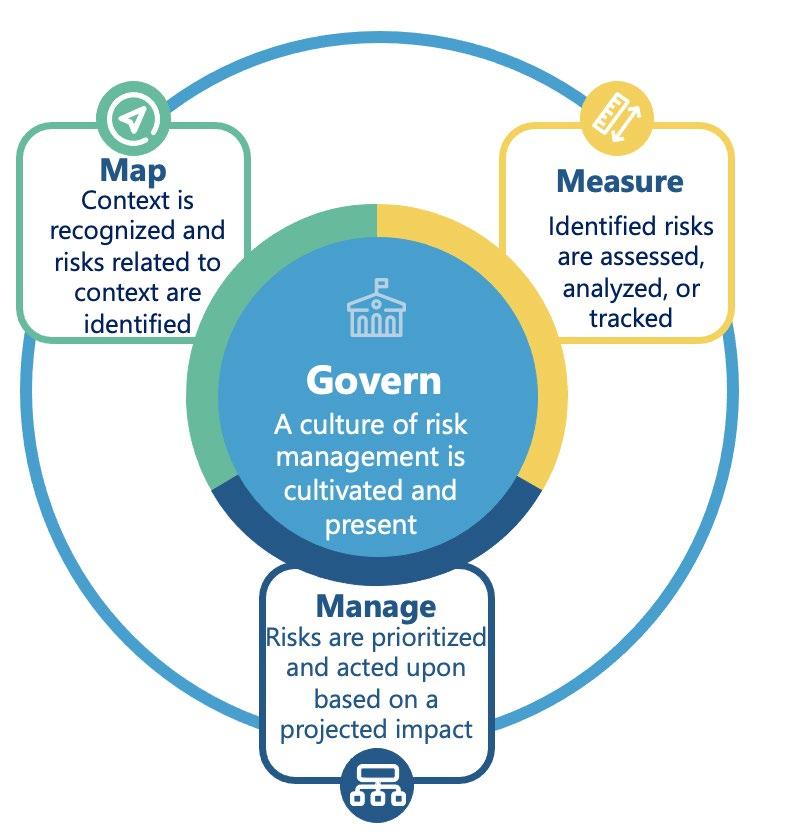
3 minute read
3.2. Challenges for AI Risk Management
Figure 3: Examples of potential harms related to AI systems. Trustworthy AI systems and their responsible use can mitigate risks and contribute to benefits for people, organizations, and systems.
The AI RMF aims to help organizations address a variety of essential risk management issues, emphasizing that context is critical. Several challenges described below stand out for managing risks in pursuit of AI trustworthiness.
Advertisement
3.2.1. Risk Measurement
AI risks and impacts that are not well-defined or adequately understood are difficult to measure quantitatively or qualitatively. Third-party data or systems can accelerate research and development and facilitate technology transition. They may also complicate risk measurement because the metrics or methodologies used by the organization developing the AI system may not align (or may not be transparent or documented) with the metrics or methodologies used by the organization deploying or operating the system. Risk measurement and management can further be complicated by how third-party data or systems are used or integrated into AI products or services. Organizations will want to identify and track emergent risks and consider techniques for measuring them.
Approaches for measuring impacts on a population should consider that harms affect different groups and contexts differently. AI system impact assessments can help AI actors understand potential impacts or harms within specific contexts. Measuring risk at an earlier stage in the AI lifecycle may yield different results than measuring risk at a later stage. Other risks may be latent at a given time but may increase as AI systems evolve.
AI risks measured in a laboratory or a controlled environment may differ from risks that emerge in operational setting or the real world. Furthermore, inscrutable AI systems can complicate the measurement of risk. Inscrutability can be a result of the opaque quality of AI systems (lack of explainability or interpretability), lack of transparency or documentation in AI system development or deployment, or inherent uncertainties in AI systems.
3.2.2. Risk Tolerance
While the AI RMF can be used to prioritize risk, it does not prescribe risk tolerance. Risk tolerance refers to the organization’s or stakeholder’s readiness or appetite to bear the risk in order to achieve its objectives. Risk tolerance can be influenced by legal or regulatory requirements (Adapted from: ISO Guide 73). Risk tolerance and the level of risk that is acceptable to organizations or society are highly contextual and application and use-case specific. Risk tolerances can be influenced by policies and norms established by AI system owners, organizations, industries, communities, or policy makers. Risk tolerances are likely to change and adapt over time as AI systems, policies, and norms evolve. In addition, different organizations may have different risk tolerances due to varying organizational priorities and resource considerations. Even within a single organization there can be a balancing of priorities and tradeoffs.
Emerging knowledge and methods to better inform cost-benefit tradeoffs will continue to be developed and debated by business, governments, academia, and civil society. To the extent that challenges for specifying risk tolerances remain unresolved, there may be contexts where a risk management framework is not yet readily applicable for mitigating AI risks. In the absence of risk tolerances prescribed by existing law, regulation, or norms, the AI RMF equips organizations to define reasonable risk tolerance, manage those risks, and document their risk management process. When applying the AI RMF, risks which the organization determines to be highest for AI systems and contexts call for the most urgent prioritization and most thorough risk management process. Doing so can mitigate risks and harms to enterprises and individuals, communities, and society. In some cases where an AI system presents the highest risk – where negative impacts are imminent, severe harms are actually occurring, or catastrophic risks are present – development




